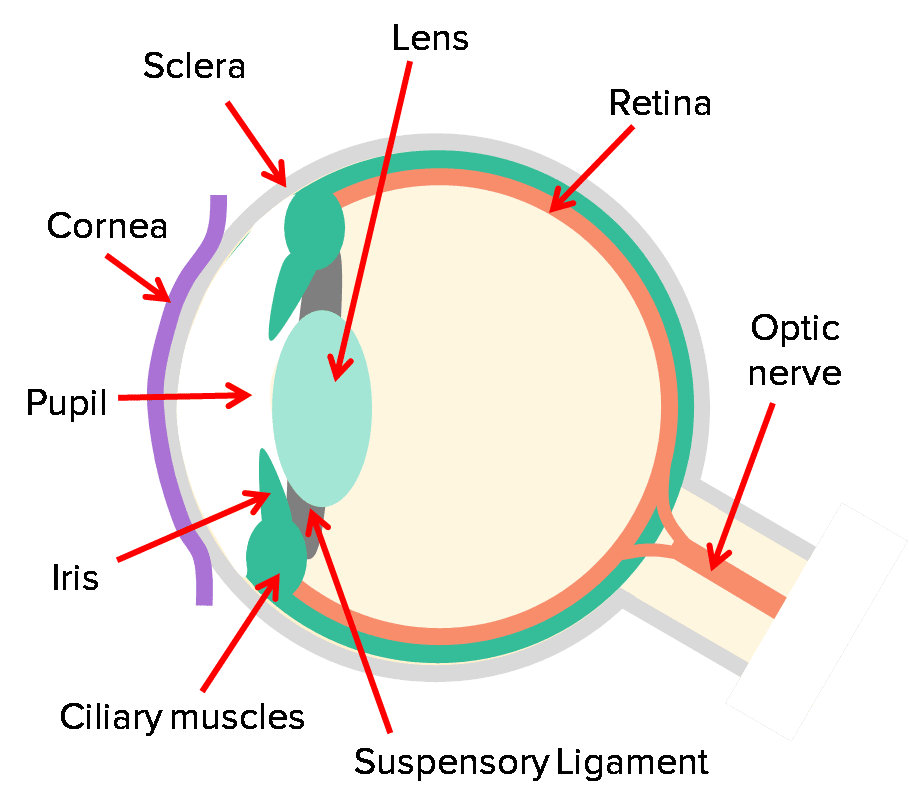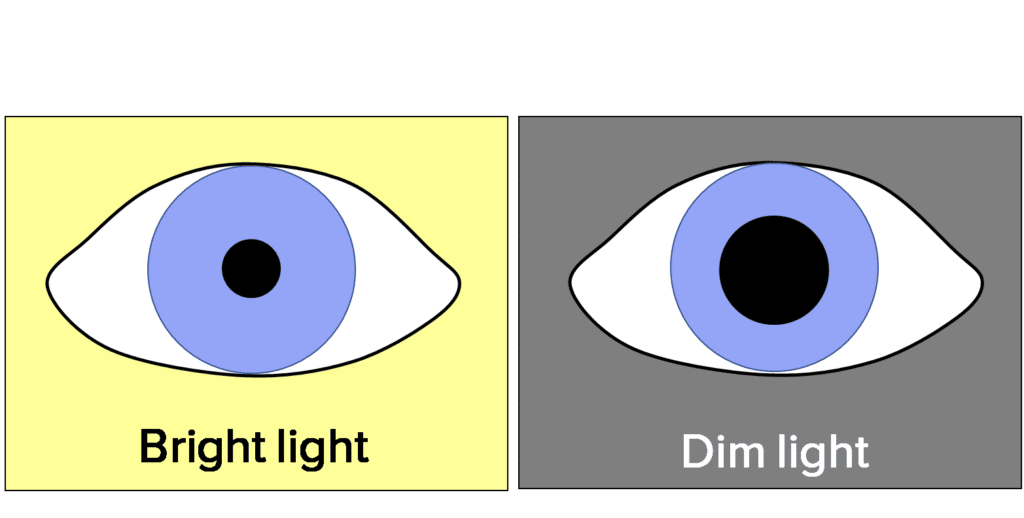The Eyes
The Eyes Revision
The Eyes
Eyes are sense organs that contain receptors that detect different light intensities and colours. Their structures allow them to perform reflex reactions such as adapting to different light intensities and focusing on objects at different distances. Some people have problems with their eye sight but these issues can often be easily treated.
Structure of the Eye

The eye is surrounded by a tough white layer called the sclera which protects it from injury.
Light is refracted by a transparent curved lens called the cornea as it enters the eye. This directs the light through a gap in the iris called the pupil.
The iris determines the size of the pupil and therefore how much light enters the eye.
The light then passes through the lens where it is further refracted and focused on to the retina.
The retina contains lots of light receptors that detect the stimulus (light) and send an electrical impulse down the optic nerve to the central nervous system (CNS).
Ciliary muscles and suspensory ligaments change the shape of the lens to help focus on objects at different distances.
Function of the Iris
The retina is very sensitive and can be easily damaged by bright light; this is why you should never look directly into the sun.
The eyes have a mechanism that ensures the amount of light entering the eye is not too much or too little:

When bright light enters the eye a reflex arc is triggered that makes the circular muscles of the iris contract and the radial muscles to relax. This reduces the size of the pupil so less light can enter.
When light is dim a reflex arc is triggered that makes the circular muscles of the iris relax and the radial muscles contract. This increases the size of the pupil so more light can enter.
Accommodation
The eye focusses light on to the retina by changing the shape of the lens in a process called accommodation.
The shape of the lens in controlled by ciliary muscles and suspensory ligaments.
When looking at a near object, the ciliary muscles contract and suspensory ligaments loosen. This makes the lens thicker and the light rays are refracted more.
When looking at an object that is far away, the ciliary muscles relax and suspensory ligaments tighten. This makes the lens thinner and the light rays are refracted only a little.

Vision Defects
Some people struggle to refract light the correct amount and therefore have trouble with their vision.
Long-sighted (hyperopia)
Long-sighted people struggle to see objects that are close to them as the image is brought into focus behind the retina.
This is either because their lens does not bend the light enough to focus on the retina or the distance between their lens and their retina is too short.
Glasses with convex lenses help by refracting the light onto the retina.

Short-sighted (myopia)
Short-sighted people struggle to see objects that are far away from them as the image is brought into focus in front of the the retina.
This is either because their lens bends the light too much or the distance between the lens and the retina is too long.
Glasses with concave lenses help by refracting the light onto the retina.

Treatments for Vision Defects
There are some alternatives to wearing glasses:
- Contact lenses are a popular alternative as they are lightweight, invisible and more convenient when on the go. They are thin lenses that sit on the surface of the eye and help refract the light correctly. There are two types of contact lenses; soft and hard. Soft lenses are generally more comfortable but hard lenses carry less risk of eye infections.
- Laser eye surgery uses lasers to change the shape of the cornea. In short-sighted people the cornea is slimmed down, reducing the amount it refracts the light and in long-sighted people the shape is changed to increase the amount it refracts the light. It comes with risks, like all surgeries, and vision could become worse than before if complications occur.
- Lens replacement surgery is where a faulty lens is removed from someone’s eye and replaced with an artificial plastic lens. As this procedure occurs within the eye it carries higher risks than other treatments; if complications occur and the retina gets damaged, the patient could lose their sight altogether.
The Eyes Example Questions
Question 1: Describe how light enters the eye.
[4 marks]
- First, the light is refracted by the cornea.
- Then it travels through the pupil.
- Then it gets further refracted by the lens.
- Finally it gets focused on the retina.
Question 2: Explain how the eye responds to dim light.
[3 marks]
Dim light triggers a reflex arc.
The circular muscles in the iris relax and the radial muscles in the iris contract.
The size of the pupil increases to let in more light.
Question 3: A person struggles to read small text in a book when it is close to their face. Explain what can you conclude about their vision and the structure of their eyes.
[3 marks]
The person is long-sighted/ has hyperopia.
The image is brought into focus behind their eyes.
The light is not refracted enough or the distance between the lens and the retina is too short.



